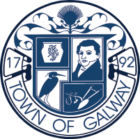Town Historian
The Town Historian has the responsibility for preserving all documents and artifacts of historical value pertaining to the Town of Galway. The Town Historian participates at the county level in organizations that focus on the preserving, studying and archiving the rich history of all of Saratoga County.
The Town of Galway Name
The whole is of settlement was originally called New Galloway in honor of the Scottish home of the early settlers. The town was formed from an area of the Town of Balls-Town (Town of Ballston). The present name was given to the area when the Town of Galway was officially formed on March 7, 1792. Local legend has it, “When the act creating the town was passed, through error or oversight, the name was Hibernicized and the town was called Galway.” A mistake was made by an Irish clerk in the county seat of Balls-town (Ballston), and so from 1792 on the town has been spelled in the Irish manner and pronounced in the Scottish way. (Jeanne Schwarz). So, New Galloway became Galway, New York.
The First Settlers of New Galloway (Galway)
In 1774, Ten families settled on land south of what now is the Village of Galway they traveled here together from a shire of Galloway, Scotland. They started clearing the land and laying out a roadway called Scotch Street, now known as Sacandaga Road. At this time the Revolutionary War broke out. The early settlers had to abandon their homes because of the hostile attitudes of the Indians and Tories. They stayed in a safer area called Schenectady until the war was over. When the war had come to an end only a small number of families returned. The Kelly family, Major family, and the McHarg family. These early settlers built their homes in New Galloway in the unbroken forest, conquering all the trails and difficulties of pioneer life.
William and Helen Kelly settled one mile south of Galway in October 1774 from Scotland with the knowledge of industry and thrift of what the Scotch people were famous for at that time. They soon had a prosperous homestead established. Their first born, Elizabeth Kelly was the first white child born in Galway on November 1, 1774. Much later her younger brother was born on May 25, 1786. The Kelly’s were an active member of the United Presbyterian Church.
John and James Major were brothers from Scotland. James was the younger brother of the two. James was killed by a fallen tree on September 11, 1776. He was the first death among the early settlers and the first one to be buried in the cemetery North of the village.
John McHarg family was related to the Major family.
Soon after settling in this area, they were followed by more settlers from the shire of Gallow in the lowlands of Scotland; John and Moses Mckindley, John McClelland, Joseph Newland, William McCartney, Mr. McWilliams, Mr. Bell and others.
John Mc Clelland
John Mc Clelland, was born 12/21/1754 in the Parish of Glaston Shire of Galloway, Scotland. He was married to Jane Hetherinton and had a son William and a daughter Jane (Boyd). He came to this country and settled in Galway when he was about 20 years old. Their house was located on the first four corners south of Galway and stood on the Northeast corner on Scotch Street. Today the location of the house where it once stood is on the northeast side corner of Donnan Road and Sacandaga Road.
John was the first town supervisor from 1792 until 1795. The first town meeting was held in April 1792. The location of the first meeting is unknown, the files were lost.
John McClelland was the first storekeeper in the town in 1780 that was located at his residence. He prospered greatly and accumulated considerable property. John was often called to official positions by the voice of his fellow citizens, and ever acquitted himself creditably of the duties of his position.
In 1794 he was elected member of the State Assembly from Saratoga County and again served in this capacity 1796, 1797, 1806, and 1808.
He is one of the founding members of the Presbyterian Church of West Charlton.
John was appointed judge of common pleas in 1806.
He died 4/12/1819 buried with his family in the Galway Village Cemetery with his wife Jane.
CONTACT
Contact: Darby Knizek-Neahr- Historian
Phone: 518-858-3986
HOURS
Those interested in reviewing the historical documents, photos and artifacts relating to Galway’s history are urged to contact the Deputy Historian at (518) 858-3986 directly to arrange for a meeting.
